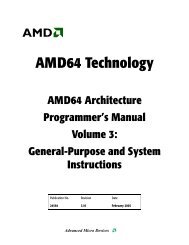Using TCP Through Sockets
Using TCP Through Sockets
Using TCP Through Sockets
Create successful ePaper yourself
Turn your PDF publications into a flip-book with our unique Google optimized e-Paper software.
when there is no data to be read yet, instead of waiting for data, read will return −1<br />
and set errno to EAGAIN. In general, a read call to a non-blocking socket will return<br />
without error any time a call to a blocking socket would return immediately. Under<br />
this definition, data is available to be read when it has been loaded into a kernel buffer<br />
by the OS and is ready to be copied into the user-specified buffer.<br />
• write. Like read, write will return −1 with anerrno of EAGAIN if there is no buffer space<br />
available for the operating system to copy data to. If, however, there is some buffer<br />
space but not enough to contain the entire write request, write will take as much data<br />
as it can and return a value smaller than the length specified as its third argument.<br />
Code must handle such “short writes” by calling write again later on the rest of the<br />
data.<br />
• connect. A <strong>TCP</strong> connection request requires a response from the listening server. When<br />
called on a non-blocking socket, connect cannot wait for such a response before returning.<br />
For this reason, connect on a non-blocking socket usually returns −1 with errno<br />
set to EINPROGRESS. Occasionally, however, connect succeeds or fails immediately even<br />
on a non-blocking socket, so you must be prepared to handle this case.<br />
• accept. When there are connections to accept, accept will behave as usual. If there are<br />
no pending connections, however, accept will return −1 and set errno toEWOULDBLOCK.<br />
It’s worth noting that, on some operating systems, file descriptors returned by accept<br />
have O NONBLOCK clear, whether or not the listening socket is non-blocking. In a asynchronous<br />
servers, one often sets O NONBLOCK immediately on any file descriptors accept<br />
returns.<br />
4.2 select: Finding out when sockets are ready<br />
O NONBLOCK allows an application to keep the CPU when an I/O system call would ordinarily<br />
block. However, programs can use several non-blocking file descriptors and still find none<br />
of them ready for I/O. Under such circumstances, programs need a way to avoid wasting<br />
CPU time by repeatedly polling individual file descriptors. The select system call solves this<br />
problem by letting applications sleep until one or more file descriptors in a set is ready for<br />
I/O.<br />
select usage<br />
• int select (int nfds, fd_set *rfds, fd_set *wfds, fd_set *efds,<br />
struct timeval *timeout);<br />
select takes pointers to sets of file descriptors and a timeout. It returns when one or<br />
more of the file descriptors are ready for I/O, or after the specified timeout. Before<br />
returning, select modifies the file descriptor sets so as to indicate which file descriptors<br />
actually are ready for I/O. select returns the number of ready file descriptors, or −1<br />
on an error.<br />
16
















